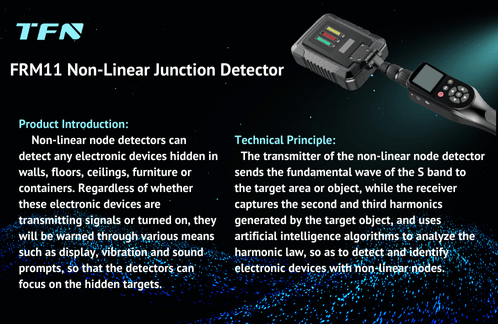What is a nonlinear junction detector? Unveiling the secrets of the "electronic hunter"
In the fields of information security and anti-espionage, nonlinear node detectors play a vital role. They are high-tech detection devices specifically designed to locate electronic devices hidden within various objects or structures, regardless of whether they are powered on or transmitting signals. So, how do they work? What powerful functions and application scenarios does it offer?
1. Core Working Principle: An Electronic Hunter Capturing "Harmonics"
The core technology of non linear junction detectors lies in their precise utilization of the physical properties of electronic components. Its operating principle can be summarized as follows:
1.1. Transmitting the fundamental wave: The device's transmitter transmits a radio frequency signal in a specific frequency band (typically the S-band, such as around 2.4 GHz) toward the target area (such as walls, furniture, or objects).
1.2. Excitation of Harmonics: When these RF signals encounter electronic devices containing semiconductor junctions (PN junctions, the fundamental nonlinear nodes in electronic components such as diodes, transistors, and integrated circuit chips), the nonlinear properties of the semiconductor material generate harmonic signals (primarily second and third harmonics, such as those around 4.8 GHz and 7.2 GHz) at frequencies different from the original frequency.
1.3. Reception and Analysis: The detector's highly sensitive receiver specifically captures these weak second and third harmonic signals. Combined with advanced artificial intelligence algorithms, the device analyzes the patterns and strength of the harmonics.
1.4. Positioning and Alert: Once the detected harmonics match the characteristics of an electronic device, the device immediately alerts the operator through various means, including audio prompts (such as pitch changes), vibration feedback, and visual displays (such as signal strength indicators), accurately locating the hidden target.
The key point: Any electronic device containing semiconductor components (PN junctions), regardless of whether it is powered on or in operation, will generate this unique harmonic response when exposed to the detector's RF signal, making it impossible to hide.
2. Core Function: Detecting Hidden Electronic Devices
Based on the aforementioned principles, the nonlinear junction detector offers the following powerful features:
Non-contact detection: Scans large areas without touching the target area.
Device-agnostic: Effectively detects target devices (such as eavesdropping devices, cameras, mobile phones, explosive device circuits, and SIM cards) regardless of whether they are powered on or off, transmitting signals, or not.
Precise Positioning: Guided by changes in signal strength, the operator can gradually narrow the scope and ultimately pinpoint the specific location of the hidden device (e.g., within walls, between furniture layers, or inside objects).
Multiple Alarm Methods: A combination of sound (pitch changes), vibration, and visual display (signal bar/indicator) ensures clear detection results even in complex environments.
High Sensitivity: Extremely high detection sensitivity, especially for small semiconductor devices such as SIM cards.
Low False Alarm Rate: Advanced algorithms effectively distinguish target signals from ambient noise, minimizing interference.
3. Key Application Scenarios: Protecting Security and Privacy
Due to its unique technological advantages, nonlinear junction detectors play an irreplaceable role in numerous areas involving security and privacy protection:
3.1. Business Security and Confidentiality
In highly sensitive locations such as company boardrooms, executive offices, R&D centers, and confidential archives, they are used to detect possible unauthorized eavesdropping devices, hidden cameras, hidden phones, or other spy devices containing SIM cards, thereby protecting trade secrets and negotiation strategies from being leaked.
3.2. Public Safety and Security
In government agencies, prisons, judicial institutions, military bases, critical infrastructure (such as airports and power plants), and major event security sites, they are used to identify potential hidden remote-controlled explosive devices, wireless detonators, mobile bombs, and other electronic devices that pose a threat to public safety, ensuring regional security. In educational examination environments, they are used to detect mobile phones, wireless earphones, and other communication devices that have been illegally brought into the examination room, thereby maintaining exam fairness.
3.3. Personal Privacy Protection
For individuals, when checking into a hotel, B&B, renting an apartment, or using a dressing room, or if you suspect your living space has been invaded, using a nonlinear junction detector can quickly scan the room and detect hidden cameras, miniature voice recorders, and other privacy-invading devices hidden in smoke alarms, power outlets, furniture crevices, and decorative items, thus ensuring the safety of your private space.
Technical Advantages and Guarantees
Modern high-performance nonlinear junction detectors (such as the TFN FM11D) typically offer the following advantages:
Independent Control: They possess fully independent intellectual property rights, are highly secure, and are not subject to foreign technology restrictions.
Precise Positioning: They utilize radio frequency technology in a specific frequency band (e.g., 2400MHz) and high-sensitivity receivers (up to ≤-140dBm) to achieve high-precision positioning (e.g., GPS module: 400-500mm, mobile phone: 180-220mm, SIM card: 90-120mm).
Safety and Reliability: They meet electromagnetic radiation safety requirements, ensuring operator safety.
Portability and Ease of Use: Their compact design (e.g., 548x170x113mm, 1.6kg) and intuitive interface make them easy for field operators to quickly learn and use. Their battery life meets typical requirements (e.g., approximately two hours of continuous operation).

Conclusion
Nonlinear junction detectors are indispensable "electronic hunters" in modern security and confidentiality systems. Leveraging advanced RF harmonic detection technology and intelligent analysis algorithms, it can penetrate various barriers and accurately identify electronic threats attempting to hide in the shadows. Whether protecting national secrets, core corporate assets, or safeguarding citizens' personal privacy, this efficient, reliable, and secure device provides a solid technical defense. As technology continues to evolve, nonlinear junction detectors will undoubtedly play an even more important role in maintaining security and privacy.
